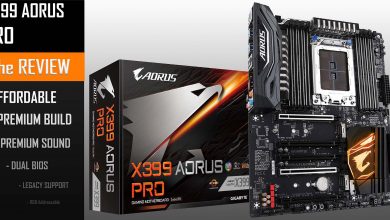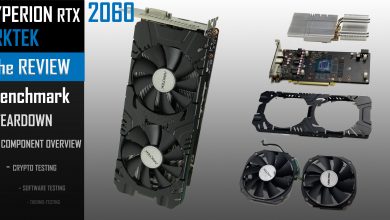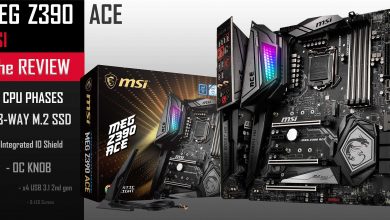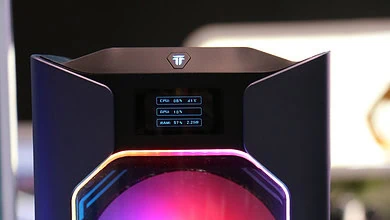Key Features
- Price: 290 USD (Confirmed)
- Release Date : 4th November 2021
- ATX Form Factor / 6 PCB Layers
- INTEL Z690 chipset
- LGA1700 CPU socket
- CPU Support
- Intel 12th Gen CORE CPU
- Intel 13th Gen CORE CPU
- 4 x 32GB 5,333 MHz DDR4, maximum 128 GB
- 2 x PCIe x16 | 2 x PCIe x1 | 1 x PCIe x2
- Back IO :
- HDMI 2.1
- DP 1.4
- 3 x USB 3.2 2nd gen. Type-A + TYPE-C RX/TX 10 Gbps
- 4 x USB 3.2 2nd gen. Type-A RX/TX 5 Gbps
- 1 x USB 4.0 RX/TX 20 Gbps
- 1 x surge protected 2.5Gbps LAN controller
- WiFi 6E
- Realtek ALC S1200A Codec 7.1 channels audio,
- STORAGE
- 4 x M.2 SSD (PCIe 4.0)
- 4 x SATA 3 — RX/TX 6 Gbps
- x14 80 AMPS power stages
- PCIe 5.0 ready
- 5,133 MHz RAM clock
- Great Premium integrated AUDIO
- AWESOME cooling blocks
- AWESOME M.2 SSD locking mechanism
- Price
- Absence of Q-LED error screen or BIOS button
The TUF Gaming Z690-PLUS WiFi D4 is the first of many Alder Lake motherboards released by ASUS. Powered by its brand new PCIe 4.0 Z690 chipset, the TUF Gaming Z690-PLUS WiFi D4 takes full advantage of the Alder-Lake advancements, in particular of its brand new PCIe 5.0 standard.
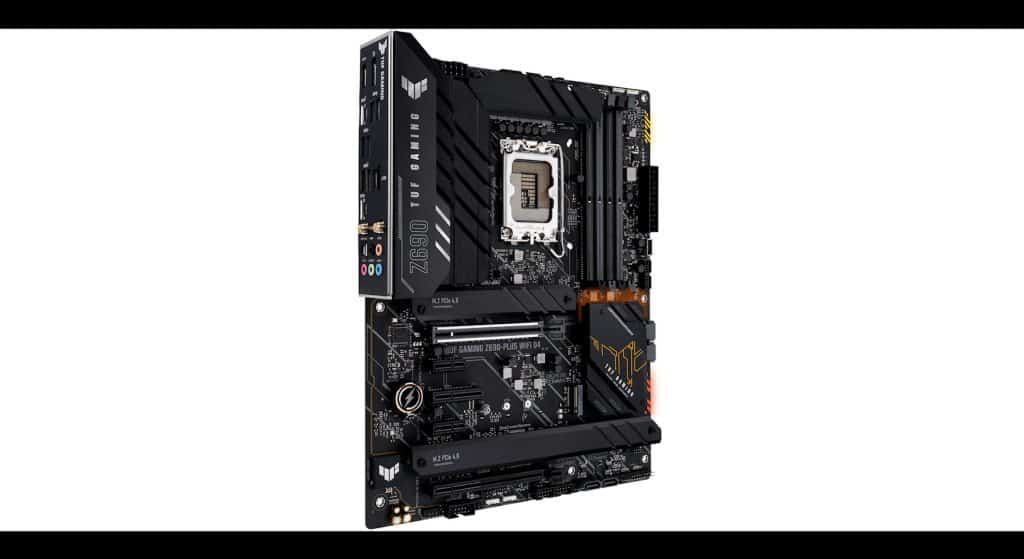
Even though both boards are fundamentally different ( in standards and CPU architecture ), the TUF Gaming Z690-PLUS WiFi D4 is aesthetically very similar to its Z590 predecessor.
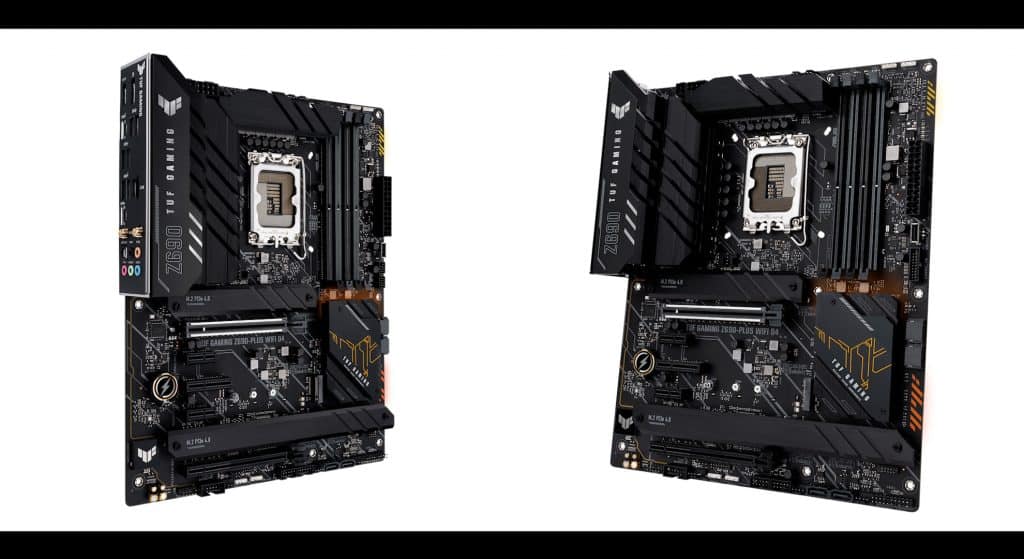
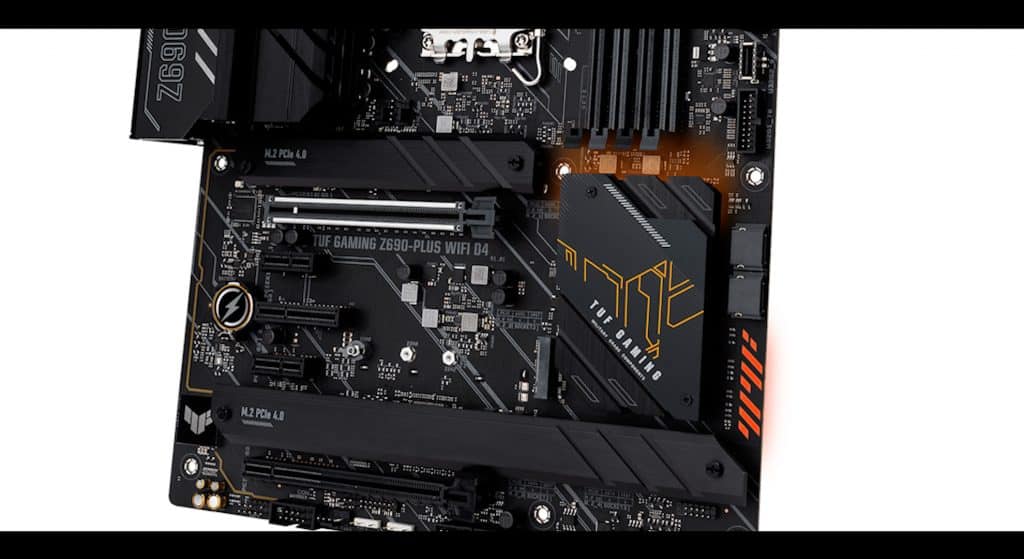
- 4 SATA cables
- Q-Connector
- TUF stickers
- TUF Antenna
- Manual
- DVD driver & Software
PCB
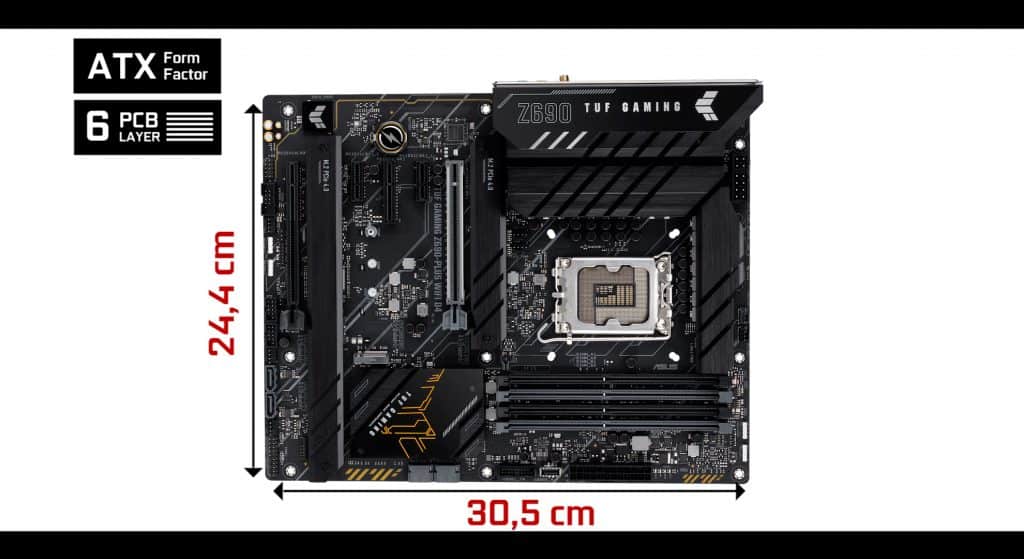
We are dealing with a 6 layered PCB ATX motherboard. Totally expected from a PCIe 4.0 enabled motherboard. Having more PCB layers (typically only 4) adds PCIe signal isolation which will allow a stable PCIe 4.0 and PCIe 5.0 support.
It also benefits VRM heat dissipation and audio quality. Obviously, a solid foundation for a performant and durable motherboard.
LGA 1700
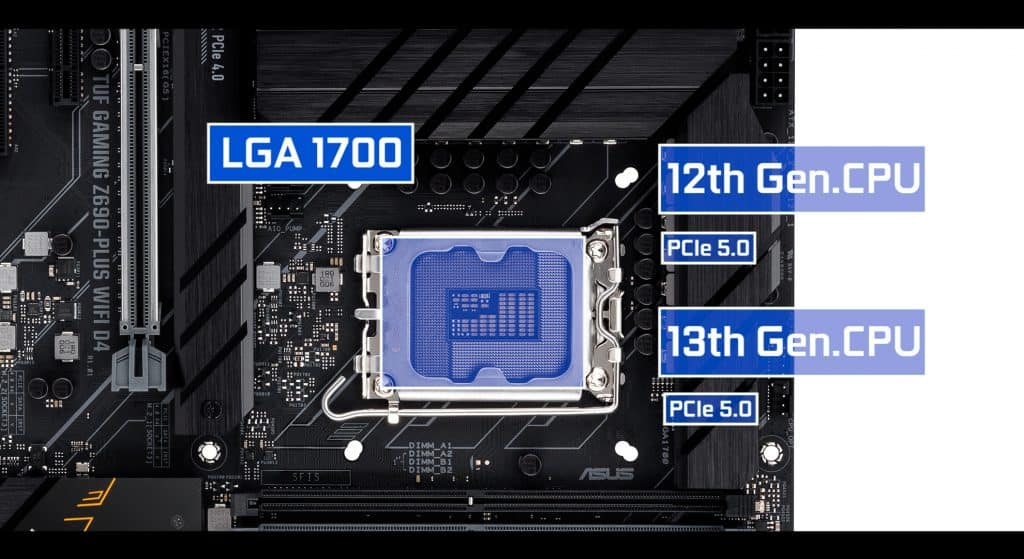
Our LGA1700 socket can support :
- 12 the Gen Intel CORE CPU
- 13 the Gen Intel CORE CPU
The LGA 1700 CPU socket features 500 more pins than its LGA1200 predecessor. This is a sizable jump made a necessity by:
- the new Alder Lake 10nm lithography, which allows more cores per CPU, and more transistors per core.
- the bandwidth increase brought by the PCIe 5.0 standard as well as the introduction of DDR5 RAM memory.

The PCIe 5.0 standard doubles its previous PCIe 4.0 bandwidth, going from 2 GB/s per PCIe lane, to 4 GB/s per PCIe lane.
This evolution brought in by Intel surprised the industry since there is no components, currently, which can use this new standard. Graphics Cards are still struggling to go beyond PCIe 3.0 level bandwidth and we do not have PCIe 5.0 enabled M.2 SSD. That last one being predominantly produced in PCIe 3.0 standard as well.
Therefore, the introduction of this new standard is more a marketing stunt than a selling argument. It does, however, make the Z690 line-up especially future proof since this standard should be around at least until 2025.
VRM
When taking a look at the 12th Gen. of Intel Core processors specs, we were all expecting a sizeable VRM upgrade. But boy was I surprised to see what was under the VRM blocks.
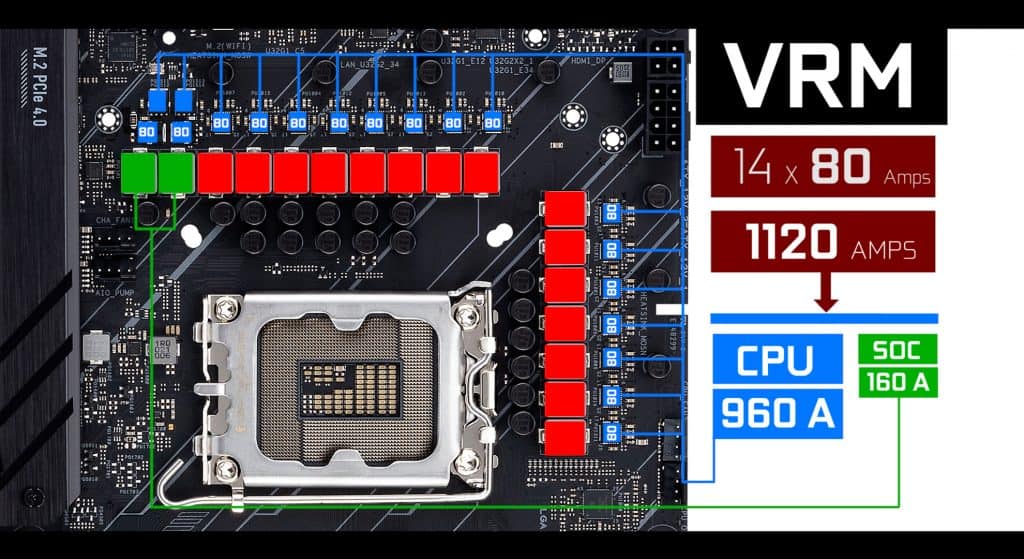
It has nothing to do with its predecessors, and truly is an unprecedent leap forward.
We have 12 80 AMPS CPU-centric powers stages, and two 80 AMPS SOC power stages, for a grand total of 1,120 AMPS.
That’s a whooping 960 AMPS worth of juice to power our processor. Obviously more, much more than you would ever need to power even the most over-clocked Intel processor of the Alder Lake line-up
VRM Cooling

We have two massive heat-sinks, identical to its Z590 TUF predecessor.

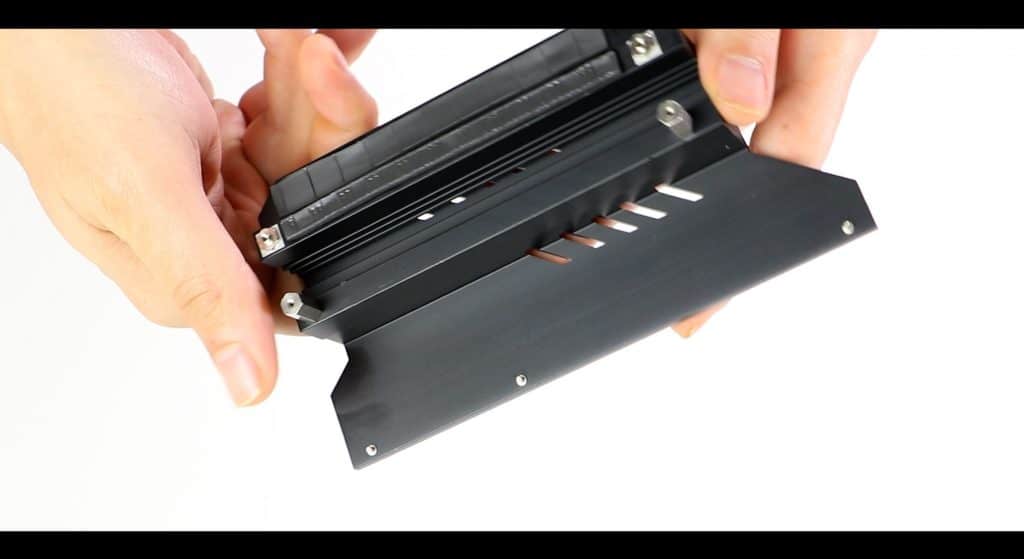
It shows impressively wide walls which will help conducting more heat towards the radiating roof.
But I specially like the fact that the entire IO roof is in fact made of aluminum and provides an extended radiating solution to this muscled-up VRM!

Finally, I want to note the double-contact design introduced by ASUS on B550 powered motherboards.
Both chokes and power stages have a thermo-padded contact to the heat-sinks, allowing a higher heat dissipation ratio.
A simple, inexpensive, but effective solution!
TEMPS
Due to the testing Embargo, at the time of writing we could not share this information. This section will be updated on the 4th of November 2021.
RAM
Z690 powered motherboards come in 2 flavors. They either support DDR4 RAM, or DDR5 RAM. In our case, the TUF GAMING Z690-PLUS WiFi D4 can support up to 128 GB of DDR4 ram in a dual channel configuration.
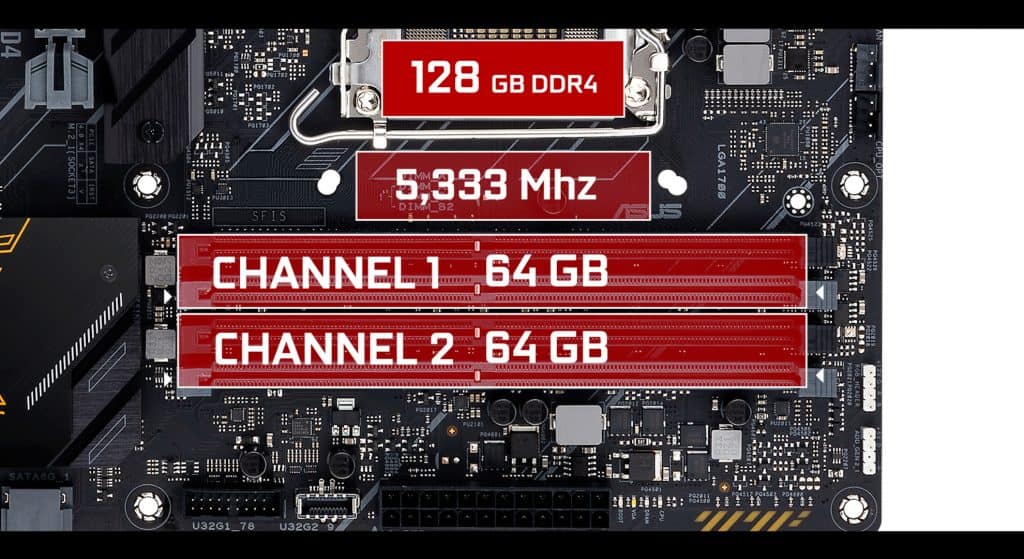
It is overclockable up to a novel 5,333 GHz ( in a single DIMM configuration ) which is noticeably more than its Z590 predecessor (200 MHz more).
Populating more memory slots will result in slower shared clocks :
- 1DPC 1R max speed 5333 MHZ
- 1DPC 2R max speed 4400 MHZ
- 2DPC 1R max speed 4000 MHZ
- 2DPC 2R max speed 3800 MHZ
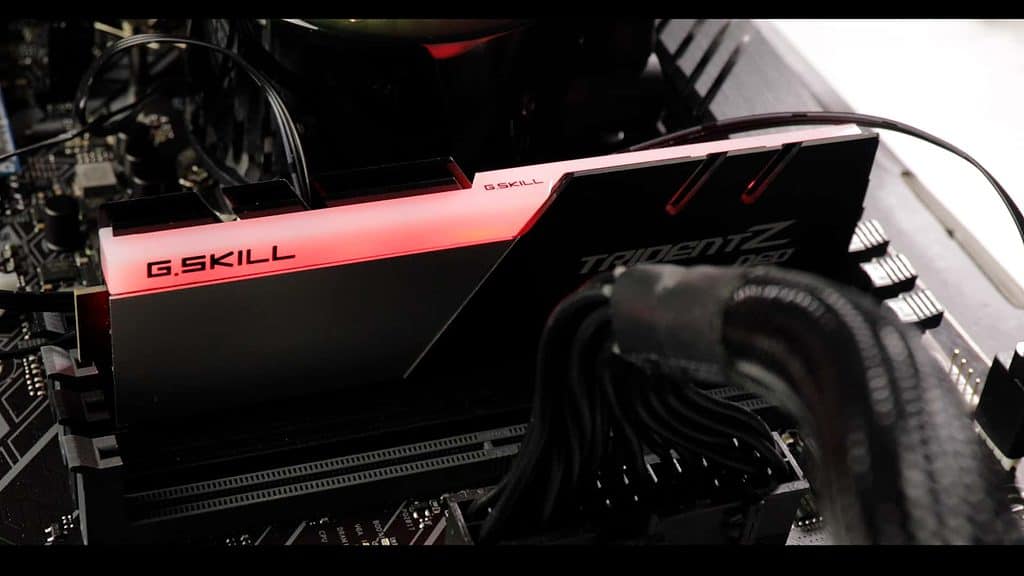
I do expect a DDR5 variant (D5) of the TUF GAMING Z690-PLUS, which will seriously improve memory performances (50% more bandwidth on identical clocks, DDR5 clocks going beyond 8Ghz).
M.2 SSD
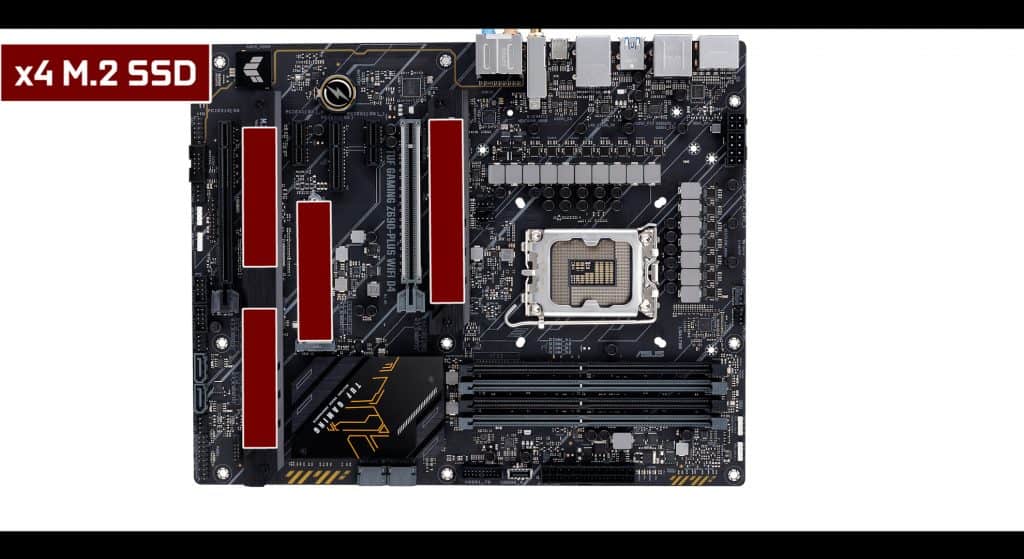
Our board can support up-to 4 PCIe 4.0 M.2 SSDs
Obviously an unprecedent jump for Intel power motherboards which could only support up to 1 PCIe 4.0 M.2 SSD module if coupled with an 11th Gen. Core processor.
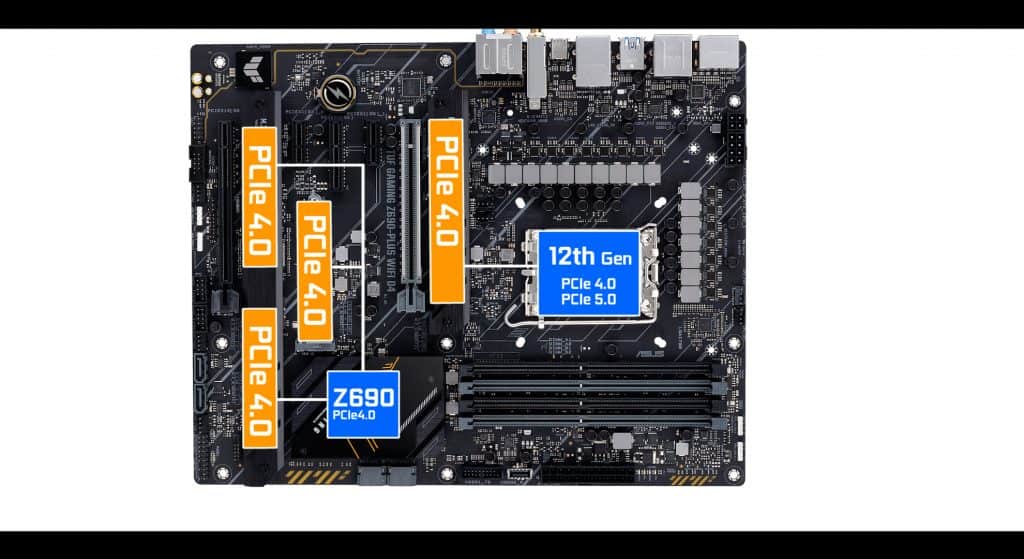
Every and each PCIe 4.0 enabled M.2 SSDs can swap data up to 64 Gbps, which propels Z690 powered motherboard ahead of AMD X570 powered motherboard over-night.
Obviously this will produce quite a bit of heat, and ASUS had the same thermal obsession it showed on this board VRM.
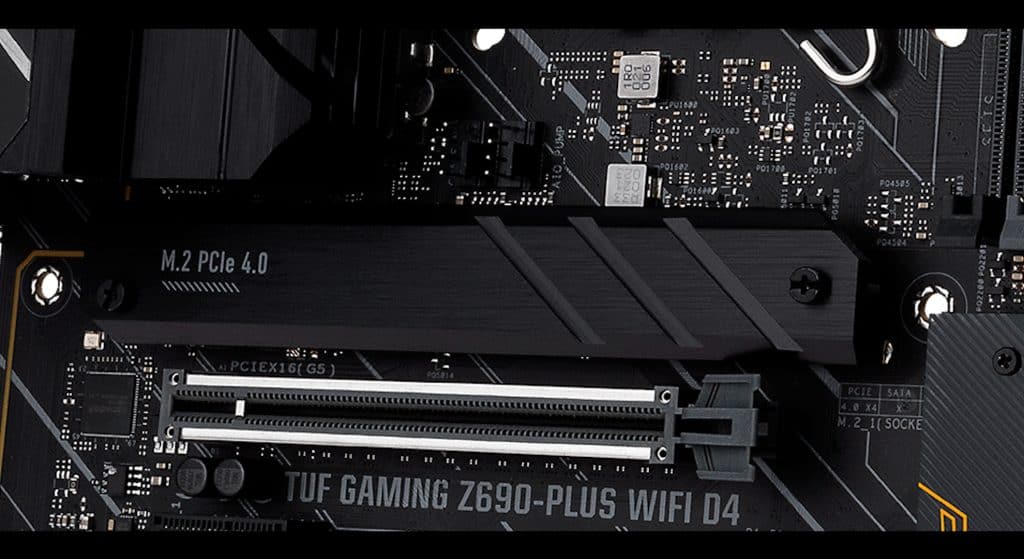
Both of our M.2 SSDs heat-shield are absolutely massive.
Obviously, more than enough to keep your PCIe 4.0 enable stick away from ever thermo-throttling.

A special mention for our our 3rd and 4th M.2 SSDs which do share the same long heat-shield.

Introduced in its predecessor, the TUF Gaming Z590-PLUS, ASUS very own M.2 SSD locking mechanism is something I absolutely love!
Tool-less, screw-less, this thing will simplify your assembling life!
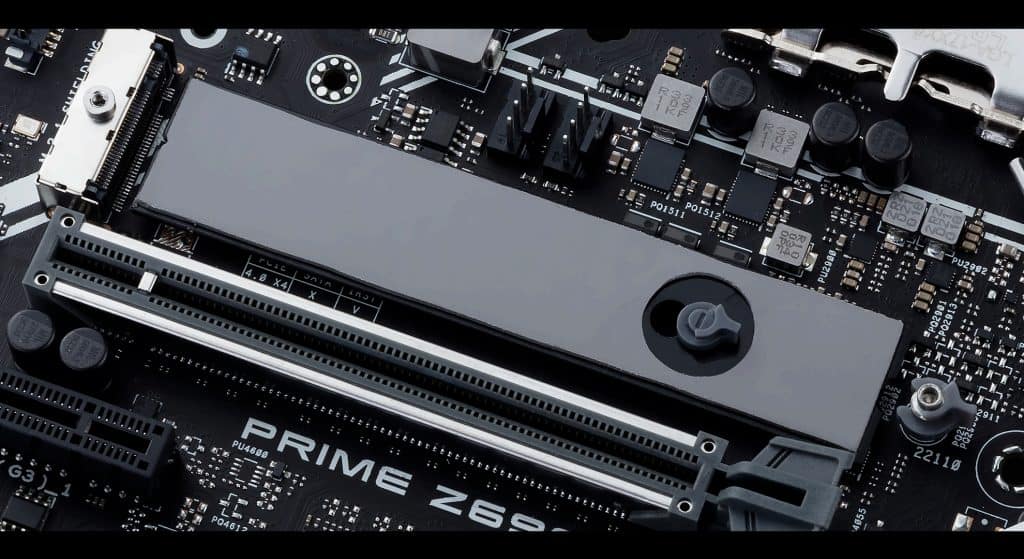
Let’s note the presence of a double thermal-padding solution for the CPU linked M.2 SSD drive. So this is where you’d want to place your booting M.2 SSD drive.
Chipset
Intel’s long-awaited Z690 chipset is its first to natively support PCIe 4.0 standards. Of its 28 PCIe lanes, 12 of them are PCIe 4.0 which has for consequence an immediate bandwidth jump, not only for M.2 SSDs but also for the back-IO which shows dramatic bandwidth upgrades compared to its TUF GAMING Z590-PLUS predecessor
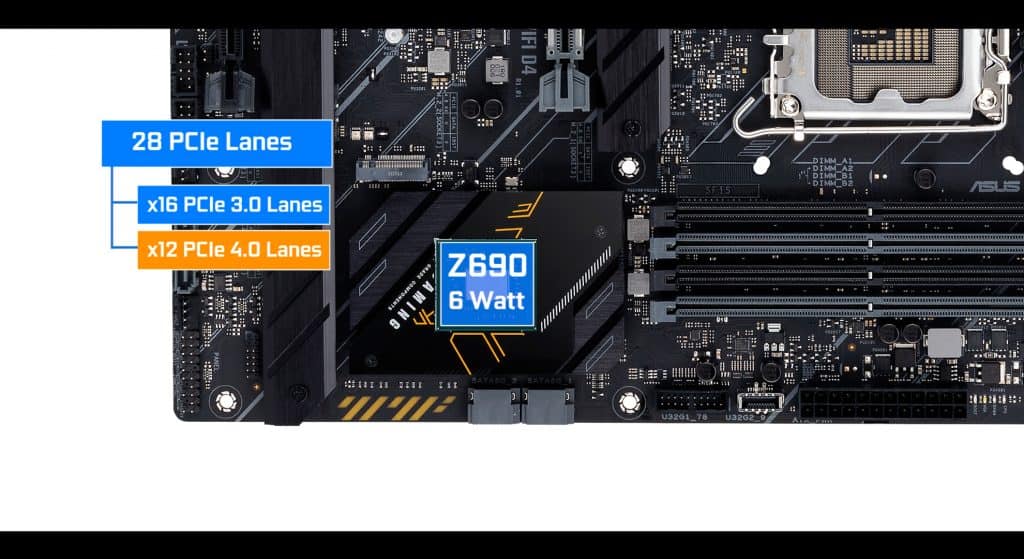
Maybe even more impressive, Intel succeeds where AMD failed, and shows a surprisingly low wattage for its Z690 chipset, allowing it to be cooled by a modest heat-sink. Something which will positively impact manufacturing cost, and hence, your wallet.
In contrast AMD’s X570 chipset features a boilling11 watts forcing most of its motherboards to be cooled with a fan, adding moving parts, noise as well as a significant cost bump.
SATA 3.0
For a more classical storage solutions, we have our usual SATA 3.0 plugs. 4 in total, with a transfer rate of 6 Gbps each. They can be configured to run into a 0,1, 5 or 10 RAID configuration.
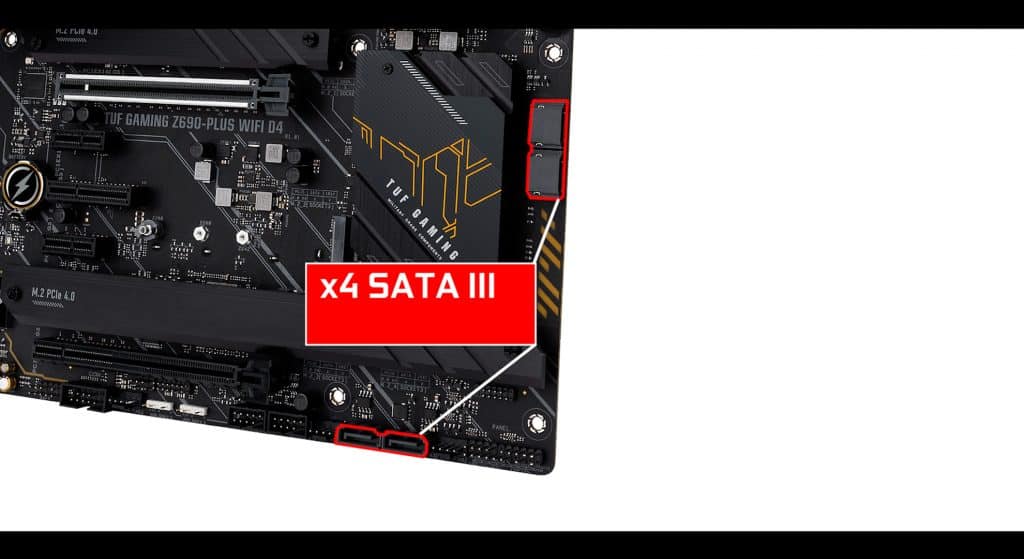
PCIe Slots
The TUF GAMING Z690-PLUS WiFi D4 has 5 PCIe expansion slots.:
- 2 16 lanes with different speeds
- 2 single lane PCIe slots
- 1 dual lane PCIe slot
Only the closest one to your CPU can deliver up to 16 Lanes worth of bandwidth meaning, this is where you’d want your video card to be placed for optimal performances.
Our second16 slots is capped at 4 PCIe (PCIe 3.0 standard) lanes, not exactly GPU friendly.

But our first PCIe 16 slot (closest one to the CPU) can output PCIe 5.0 bandwidth at 4 GB/s per lane, for an impressive total of 64 GB/s.
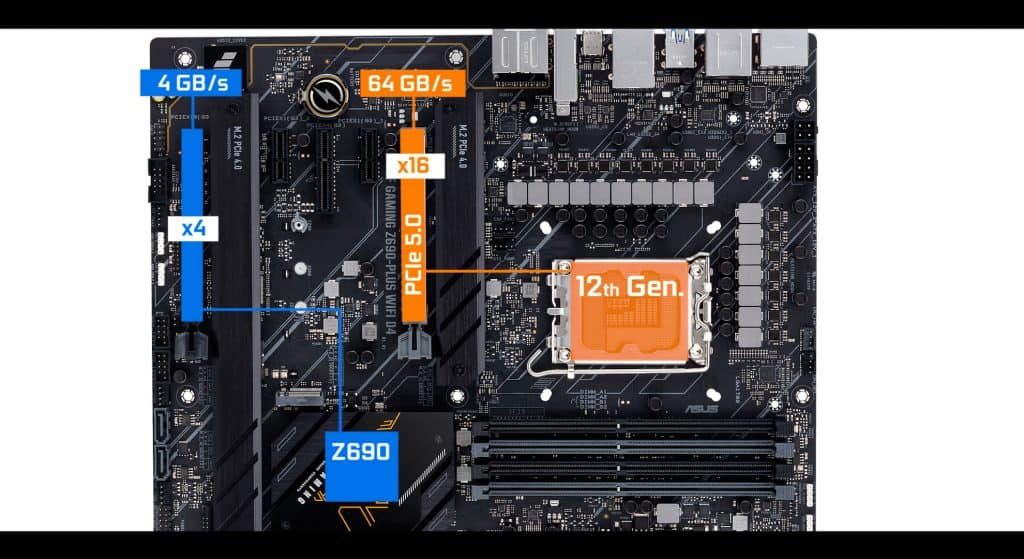
Worth noting that, with the current bandwidth outputs of AMD or Nvidia graphics cards, there are no performance gains between PCIe 3 or PCIe 4 or even PCIe 5 standards.
It is great for future proofing (and marketing), but that’s about it .
Back IO
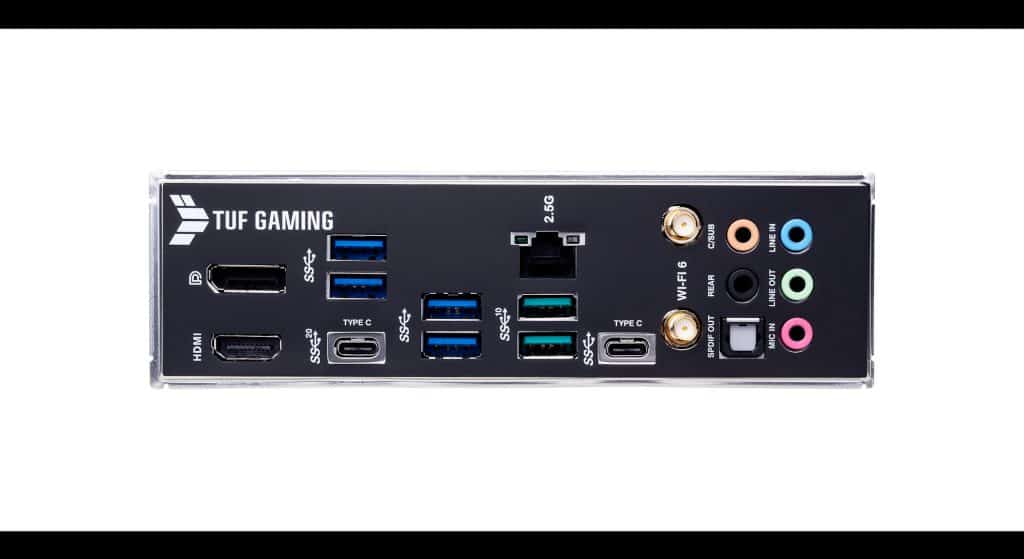
First let me note the presence of an IO integrated plate which is always a good point!
- 2.1 HDMI (4k@60fps)
- 1.4 DP (4k@60fps)
- WiFi 6 Dual Band AX201 adaptor (2.4 Gbps) / BT 5.2
- x3 USB 3.2 2nd GEN USB (10 Gbps) including a TYPE-C.
- x1 USB 4.0 Type-C (20 Gbps)
- x4 USB 3.2 1st Gen (5 Gbps)
- x1 surge protected (TUF LANGUARD) Intel I225-V 2.5Gbps LAN controller (step 3)
- ALC S1200A REALTEK audio codec, which is about the best integrated AUDIO Codec a board can have. It takes full advantage of the numerous PCB layers available to it, since both left and right audio channels have been traced on individual PCB layers, further improving its signal isolation and protecting it from static interferences.
Great for playing and recording alike.
Front Panel Connectors
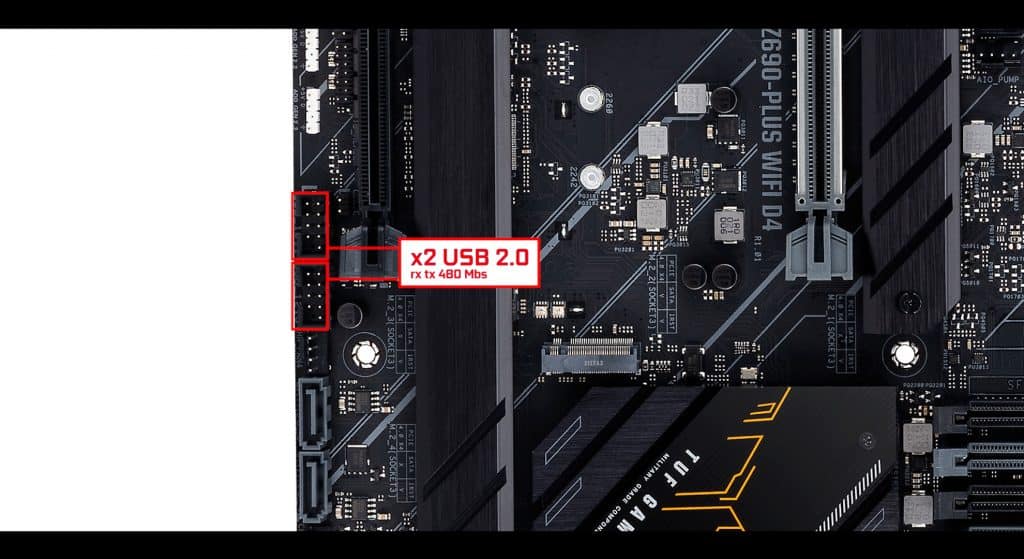
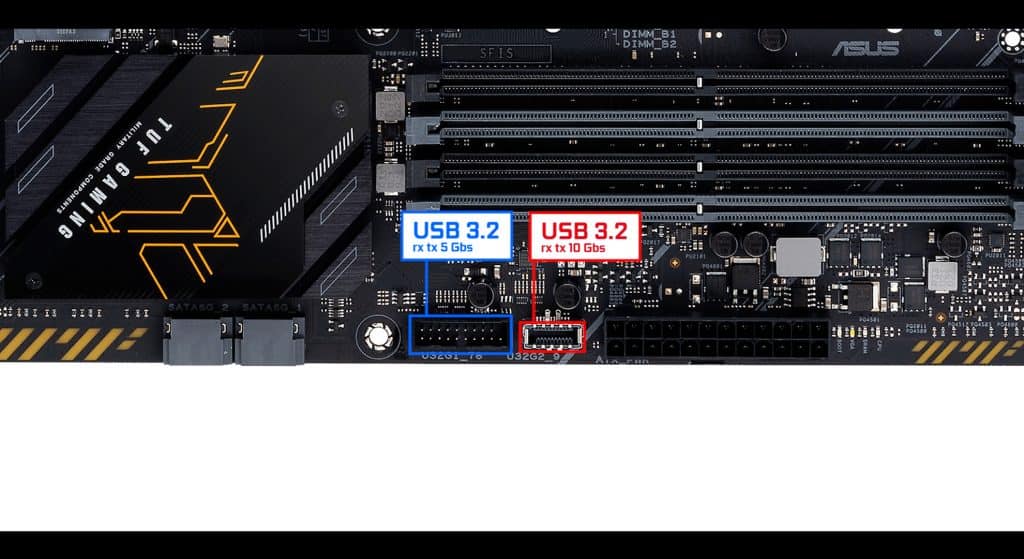
We have :
- 2x 2nd gen USB front panel connectors , good for our AIO pumps, or PSU monitoring,
- 1x 5Gbs USB 3.2 (1st Gen) front panel Connector
- 1x 5Gbs USB 3.2 (2nd Gen) TYPE-C front panel Connector
Overall a well furnished board-based peripherals in par with its pricing.
Cooling connectors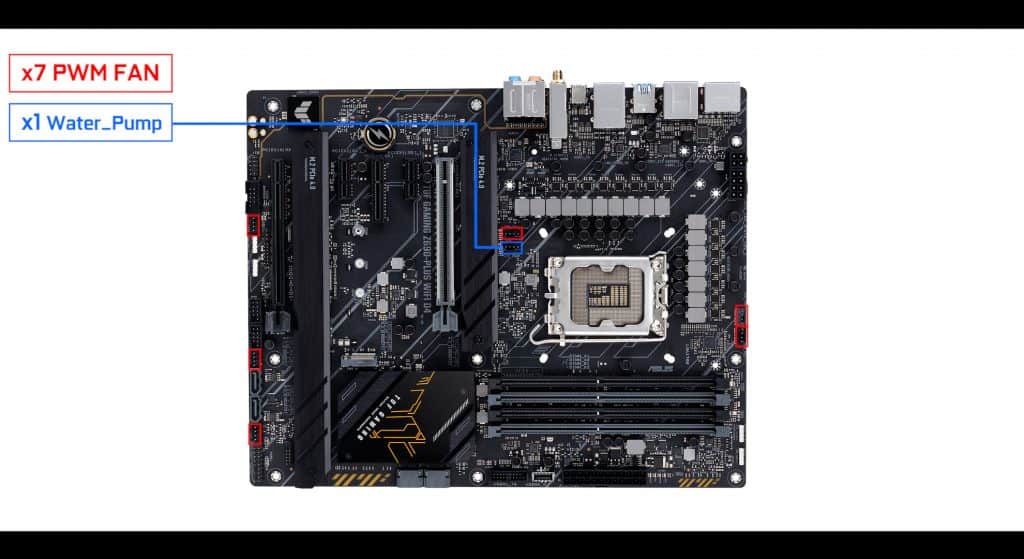
We have 7 nested PWM FAN connectors, 1 of which can support a water pump (AIO or dedicated).
Definitely what you want to see on an enthusiast driven board. It can handle about any cooling solutions you will throw at it. Spanning from the classic air to the eccentric dual-loop custom water cooling apparatus.
EZ Debugger
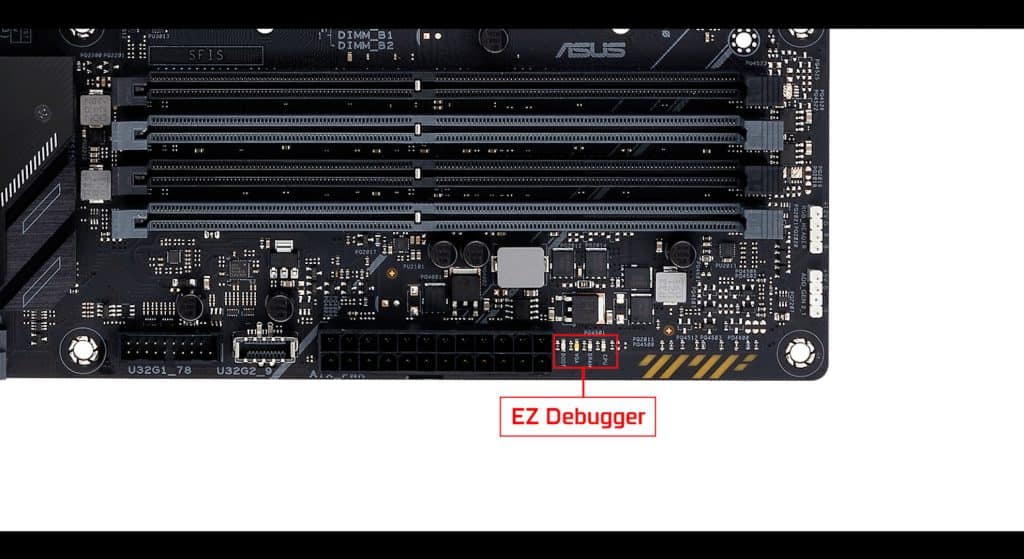
The EZ debugger is really the a must-have on PCIe 4.0 / PCIe 5.0 enabled boards. More often than not, enthusiasts can’t resist the call to find their RAM or CPU overclocking limits, and fail boots becomes a daily incidence.
The EZ debugger will give us a first-aide troubleshooting guidance one what stage of the boot your system failed.
AURA Sync Effect
RGB wise, the TUF GAMING Z690-PLUS WiFi has 2 nested RGB strips :
One under our chipset heat-shield,

and one lining the motherbaord’s PCB,
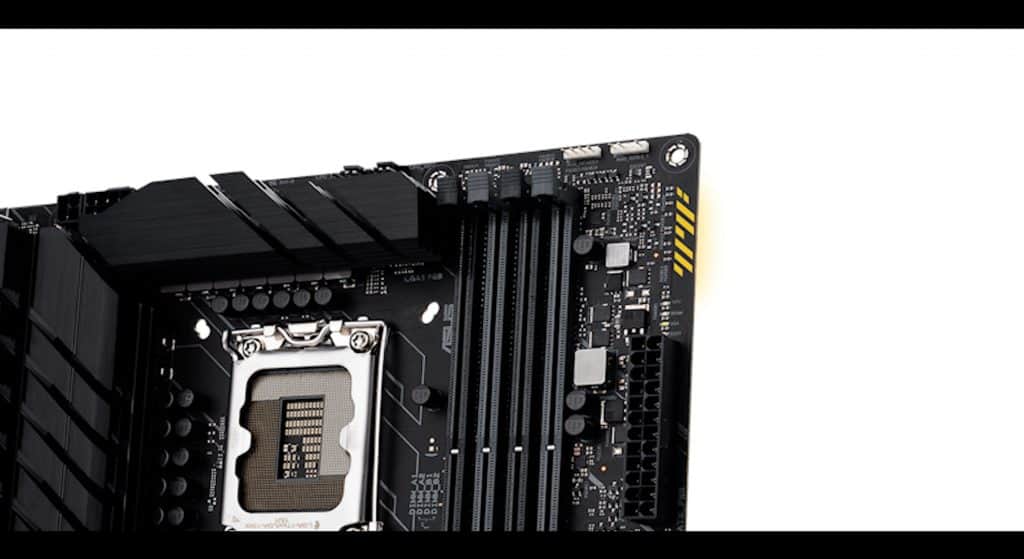
In addition we also have 4 RGB connectors :
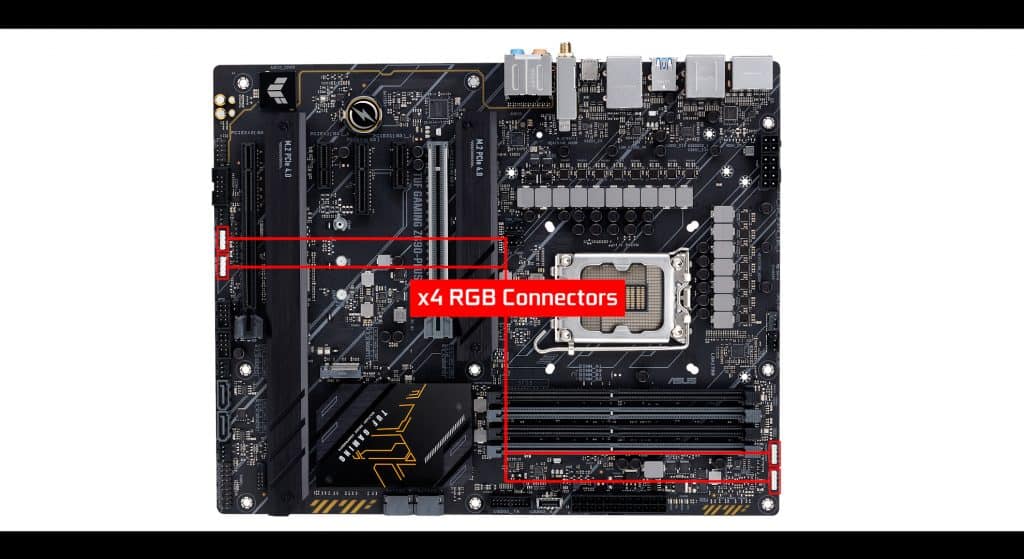

- 1 classic AURA RGB Connectors
- 3 Addressable AURA RGB Connectors
All of the above are obviously fully customizable (and sync-able) through ASUS proprietary AURA software or ARMOURY Crate.
CONCLUSION
At about 290 USD the TUF GAMING Z690-Plus Wifi is about 40 bucks more than its Z590 predecessor, and the all question is: is it worth it?
ABSOLUTELY YES!
There is very little which can go wrong with this board. Not only does it give you access to Intel’s Alder-Lake processing power, which far surpasses its 11th Gen Processor or even its Ryzen competitor, but it does provide serious future proofing arguments with its introduction of the PCIe 5.0 standard.
The motherboard on its own does a splendid job in providing plenty of quality power to your CPU, and is probably one of the most efficient (heat-wise) for its class.
I do regret not having more troubleshooting options such as a BACK-IO BIOS buttons but other than this, it is a straightforward resilient, powerful solution for all mid budget gamers/streamers, and probably the last component to survive the test of time!
In short, ASUS did a fantastic job in bringing TUF up to the ALDER-LAKE standard and a must-buy!

